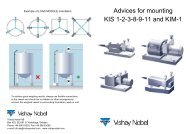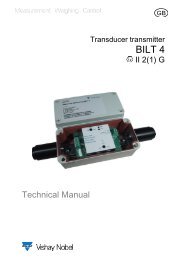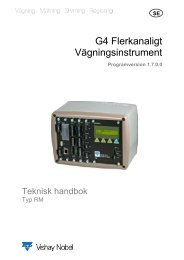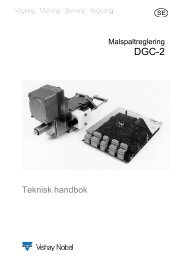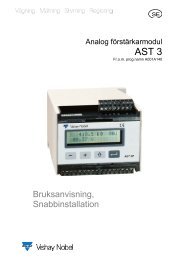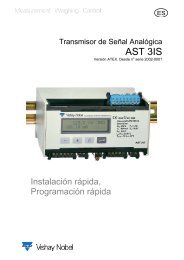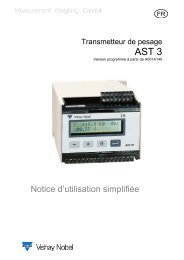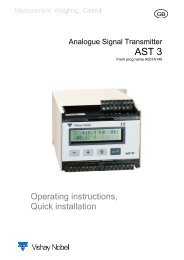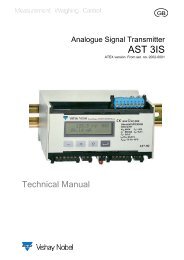G4 Multi Channel Weighing Instrument. PM/DT/HE Technical Manual
G4 Multi Channel Weighing Instrument. PM/DT/HE Technical Manual
G4 Multi Channel Weighing Instrument. PM/DT/HE Technical Manual
Create successful ePaper yourself
Turn your PDF publications into a flip-book with our unique Google optimized e-Paper software.
<strong>G4</strong> <strong>Multi</strong> <strong>Channel</strong> <strong>Weighing</strong> <strong>Instrument</strong>Set zeroSet zero is useful only when the scale installation is finished. By the digit keys thisvalue can be set to zero, for unloaded scale, or to the weight of the known load, for ascale that is loaded.Zero offsetFor an installed scale this parameter shows the zero offset after zeroing, a value thatshould not be edited.For a scale that is not installed it is possible to enter the known weight of fixedequipment on the scale.Table calibrationTable calibration can be used to copy recorded values from a previous deadweightcalibration of the weighing equipment into a replacement instrument. This is performedby entry of recorded weight values and corresponding transducer signal values into theinstrument. Calibration can be performed for up to 6 points.The accuracy of the copying procedure is 0.005 %.No of Calibration PointsOnly parameters for the selected number of calibration points will be displayed inthe menu. The number of calibration points can be changed during the calibration.Value Cal. P1, Value Cal. P2 etc.These parameters are used for entry of recorded weight values, expressed inthe measurement unit, from a previous deadweight calibration.Transd.Signal P1, Transd.Signal P2 etc.These parameters are used for entry of recorded transducer signal values forcorresponding calibration points.Set ZeroSet zero is useful only when the scale installation is finished. By the digit keys thisvalue can be set to zero, for unloaded scale, or to the weight of the known load, for ascale that is loaded.Zero OffsetThis parameter is used for entry of the recorded zero offset value from a previousdeadweight calibration.If a zeroing has been performed with parameter ‘Set zero’ above, the value ofparameter ‘Zero offset’ need not be changed.Deadweight calibrationThis is normally the most accurate calibration type. The transducer signals aremeasured and automatically stored when the scale is loaded with known weights.Calibration can be performed in up to six calibration points, starting with the lowest,the highest point, or any other order.Calibration of the lowest point is normally performed with the scale unloaded.If calibration in two points is used, the second point should be placed as high aspossible, the scale should be loaded with at least 2/3 of the ‘Capacity’.By calibration in more than two points, the highest calibration point should be placed at,or higher than, the highest load for which the scale is to be used, and the calibrationpoints should be evenly distributed in the measuring range.No of Calibration PointsThis parameter defines the number of calibration points. Up to six points can beselected, and parameters for load value and transducer signal will be displayed only4-5



